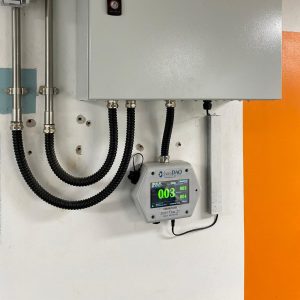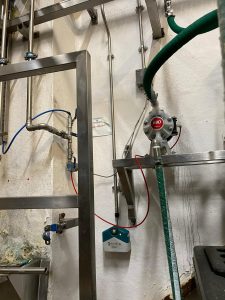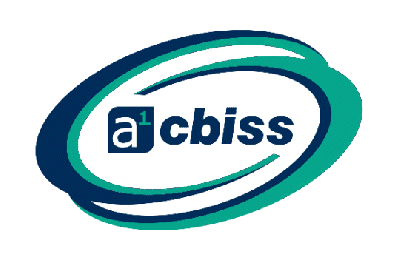Introduction
We all love a delicious and tasty, ice cold glass of the white stuff. But to guarantee milk is safe to drink, milk production facilities must frequently flush the bottle filling lines to keep them sterile.
Peracetic acid (PAA) is used as the sterilant. It’s regular use within the production facility means that PAA is stored and used in large volumes.
Aseptic lines consist of equipment to sterilise, rinse, and fill using Cleaning-In-Place (CIP).
a1-cbiss were approached by a large milk processing facility that produces 1.5 million bottles every day and employs hundreds of people. The dairy had concerns about PAA exposure and wanted to install peracetic acid monitoring in milk production areas.
The Problem
Whilst the use of PAA has excellent properties as a sterilant, it does pose significant health risks to people should they be exposed to it.
Because the plant uses large volumes of PAA, the level of risk increases and provides a constant threat to people working there.
Following an eye-opening incident, the Production Manager at the plant became aware of the real dangers and wanted to install a gas detection system capable of monitoring for leaks and alarming if there’s a threat of dangerous levels of vapours.
Overexposure to PAA can cause severe effects on the human body.
- Burning and irritation of the skin and eyes leading to eye damage
- Nose and throat irritation
- Irritation of the lungs causing coughing and shortness of breath
- Long-term chronic health effects to the liver, heart, and kidneys

The Solution
As with all projects, a1-cbiss carried out a site survey. A site survey helps a1-cbiss to build a complete picture of what’s needed on site by considering noise levels, lighting, the size of the facility, the walkways that workers use, means of escape, the layout of the aseptic lines and PAA storage areas.
An installation assessment is also carried out to review the power points, see where the detectors and alarms could be placed, to check whether there would be any problems drilling the walls (asbestos or reinforced materials) and to review the quality of existing trays for the cabling.
There’s also a discussion with the production manager and health & safety team to identify what they need from the project.
a1-cbiss supplied the Steri-Trac 2+, a continuous area gas monitoring system manufactured by ChemDAQ. This is the most stable system that is available for monitoring airborne peracetic acid monitoring in milk production.

The site survey identified that nine PAA sensors were required throughout the production facility. Given the noisy environment, traffic light visual beacons were mounted at the end of the walkways for maximum visibility.
![]()
The Steri-Trac 2+ was installed with remote sensor mounts, so the controller can be mounted remotely from the sensor. The sensors were placed near to PAA storage areas and next to the various aseptic line whereas the controllers were mounted near to the doors.

In addition, a1-cbiss were able to configure the system to send a text & email alert to the Shift Team Leader in the event of an alarm threshold being met – perfect for when times when there were lone workers.

The Steri-Trac System
Steri-Trac provides the optimal solution for workplace safety assurance, utilising low- & high-level configurable alarms and a data acquisition module.
The Steri-Trac sensors communicate with the site’s data acquisition system. The real-time readings are calculated and reported into short and long-term exposure limits. A short-term exposure limit (STEL) is set to 0.4ppm over a 15 min period.
Maintaining an accurate and reliable system is easy with the SXP (Sensor Exchange program). A pre-calibrated sensor is shipped to the customer every 4 months. The sensor modules are plug and play, therefore do not require a service engineer to install.
Talk with the Experts
Contact us - Our team of application specialists can assist you with system design, installation, maintenance, and repair. As a systems integrator, we provide end-to-end support to ensure your facility has a reliable and effective gas detection system in place.
Sign up for more information - For more information on protecting your staff from the dangers of gas leaks, sign up for our emails.




